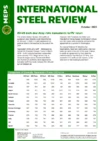Data centre construction boosts US steel consumption
US Census Bureau statistics have highlighted data centre developments as one of the few bright spots in a construction sector weighed down by elevated interest rates.
The Bureau’s latest monthly construction spending report detailed the value of investments in data centres for the first time. It confirmed industry commentators’ long-held belief that data centres are the fastest growing construction segment in the US market.
Data centre construction – previously included in the Bureau’s ‘office construction’ category – has more than tripled over the last three years. The Bureau's report showed that investment in the sector had reached over USD27 billion (annual rate) and continues to grow, rising by 69% year-on-year in May.
Although data centre developments’ share of total construction spending is below 2%, their growth over the past decade – and particularly the past three years – has contributed to the US construction industry’s levels of structural steel consumption.
MEPS International US steel market consultant, Laura Hodges, said that steel producers and service centres need to understand the entire value chain for building a data centre, and target those companies, to fully benefit the most from the sector’s “extraordinary growth”.
US leads the way with new data centres
According to Data Centre Magazine, the United States is the epicentre for the data centre industry. It has the largest number of data centres in the world (approximately 2,700), followed by Germany, the United Kingdom, China and the Netherlands. Furthermore, the total number of US data centres easily exceeds the number of data centres in the next five largest countries combined.
Data centres need a reliable and abundant supply of electricity, one of the reasons for their large concentration in the US. Data centres account for an estimated 2% of US electricity usage, according to the US Department of Energy. Skilled labour, a reliable water supply and a low risk of natural disasters are also key factors for choosing a data centre location. Consequently, Northern Virginia is the largest data centre market in the US.
The global surge in data centre construction has been building for several years. More recently, the emergence of artificial intelligence and cloud computing has accelerated the pace of growth. McKinsey, a global consultancy, has predicted that this boom will continue, growing 10% annually until 2030. Based upon expected demand and current supply, that prediction could be underestimated, however. CBRE, a commercial real estate services and investment firm, estimates that just 0.9% of data centre capacity in Northern Virginia was unoccupied in quarter one of 2024, despite significant new developments in the period.
Most steel products benefit from data centre boom
The demand for increased data centre capacity in the US bodes well for the country’s steel industry. Nucor’s recent acquisitions of Southwest Data Products (2024) and Hannibal Industries (2021), and the subsequent creation of the Data Systems business unit, highlight the growing importance of data centres to future demand growth for the US steel industry.
Steel is used in multiple applications within the construction of a data centre. Besides the traditional role that steel played in nonresidential construction, it is also used in the racking, server enclosures, cooling systems, piping, and power generation equipment, supporting demand for both flat and long products.
Hodges said: “The number of manufacturing and construction firms involved in building a data centre is currently quite scattered. There are construction firms, rack and enclosures fabricators, heating ventilation and air conditioning (HVAC) manufacturers, power generation equipment producers, piping companies and more. That is why the Nucor acquisition and creation of a separate business line for data centres is so important as they attempt some consolidation in this market.
“Service centres or steel producers need to understand the entire value chain for building a data centre and target those companies or begin to acquire some of players in the sector. Steel companies that are successful will benefit the most from this extraordinary growth expected through at least the end of the decade.”
While the trajectory for data centre construction is robust, MEPS International does not expect the trend to result in higher steel prices in the US during 2024. MEPS predicts that flat product prices will only move marginally higher in the second half of the year as new capacity and weak overall demand continue to subdue steel prices.
- Monthly US steel market commentaries, prices, indices and forecasts are included in MEPS’s International Steel Review. The publication also provides insight from key steel markets across Europe and Asia, covering 70% of global consumption. Contact MEPS or visit mepsinternational.com for details of how to subscribe.

Source:
International Steel Review
The MEPS International Steel Review is an essential monthly publication, offering professional analysis and insight into carbon steel prices around the world.
Go to productRequest a free publication





